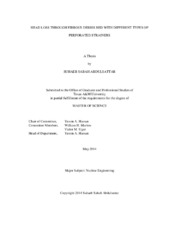| dc.description.abstract | Safety related issues in Nuclear Power Plants (NPPs) have always been of
concern, especially those issues that are related to Light Water Reactors (LWRs) and
their Design Basis Accidents (DBA). One of the ongoing issues that has been
extensively studied is the Generic Safety Issue GSI-191, which is dedicated to study and
resolve the issues that arise after a Loss-Of-Coolant-Accident (LOCA). Fibrous debris
produced during the blow-down phase of Loss-of-Coolant Accidents is transported into
the sump and becomes an important cause of head loss through the sump strainer,
affecting the Emergency Core Cooling System (ECCS) performance. This study was
dedicated to measure the pressure drop across randomly accumulated debris bed on the
sump strainer along with measuring the debris bed thickness. Two different types of
strainers were installed vertically, one at a time, in a horizontal flow loop and the debris
bed thickness was measured during the bed build up process and after reaching steady
state. Fifteen tests were conducted to determine the head loss difference between the two
strainers and to study the characteristics of the debris bed accumulated on each strainer.
The results from this experimental study were compared based on the approaching
velocity, debris bed thickness, and strainer type. A realistic permeability model for the
NUKON fiber glass insulation material was suggested, to be utilized in related
applications, the suggested head loss model was compared to other head loss models
developed in previous studies. The permeability model was developed from
experimental data acquired from approaching velocities in the viscous region. There was
no significant head loss difference between the two strainers for the minimum and intermediate range. Based on the experimental data, the head loss difference between the two strainers for the maximum range was about four times higher than the calculated head loss. The flow rate measurement uncertainty was main reason for the difference in the maximum range. There is a probability that the debris bypass could be different between the two strainers, thus, a debris bypass study is required to further investigate this difference. | en |


